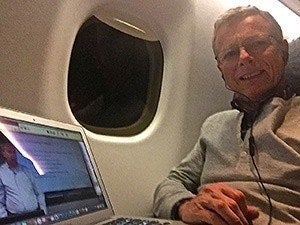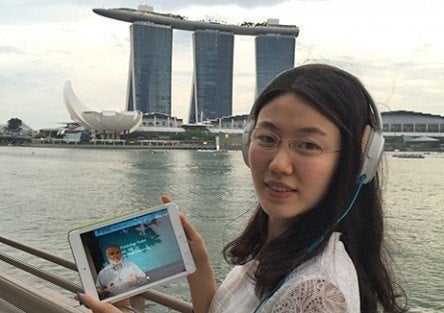January 12, 2016 — Between shifts in a California hospital, on lunch break in Singapore, or on an airplane soaring over Canada, students from all over the globe are now studying epidemiology in a new Harvard T.H. Chan School of Public Health master of public health (MPH) program that blends online, on-campus, and in-the-field learning. It is the first such degree program to be offered at a Harvard professional school.
Students in the two-year MPH in Epidemiology program, which launched in June 2015, say they love the program’s flexibility and quality.
Jaimie Shaff, who works in human resources and finance for Doctors Without Borders/Médecins Sans Frontières, currently works in New York City but is slated for field work next year. She hopes to use her epidemiology training to better understand and treat mental trauma in vulnerable populations. She said she would have had to leave the humanitarian field for a year or two if she’d signed up for a residential degree program. “Given the extent of humanitarian needs at the moment, this was not something I was morally prepared to do,” she said, adding, “The program has exceeded my expectations. The coursework is rigorous, and the professors and teaching staff are truly dedicated.”

Peter Gladstone, an interventional cardiologist from Toronto who has been watching lectures via video downloads during his frequent flights to the Canadian Maritimes, called the program amazing. “The instructors and teaching assistants are the best I have ever encountered in 13 years of post-graduate study, honestly!” he said.
Faculty and administrators say the program is also helping full-time students on campus as it changes how faculty think about the way they help students learn overall at the School.
“We have some of the School’s best teachers in this program,” said Ian Lapp, associate dean for strategic educational initiatives. “And we are getting consistent feedback from faculty that learning to teach in this medium is expanding their pedagogical repertoire and further improving the quality of the education that we offer—both for students studying online and for residential students.”
“The new program is faithful to our School’s century-old tradition of public health and epidemiology teaching excellence, all while making judicious use of the technological advances of today,” said Michelle Williams, chair of the Department of Epidemiology. “Now students can complete our top-quality MPH degree program without having to completely withdraw from their research or practice careers.”
Impetus for the new program came from Harvard Chan School’s early involvement in HarvardX, which brings free online Harvard courses to thousands around the globe. Over the past four years, the School has developed 10 massive open online courses, or MOOCs. Both HarvardX courses and the new epidemiology program take advantage of new technologies to boost educational initiatives.
“While we firmly believe in the virtues of residential experience in Boston, and this new degree has a one-third residential component, the MPH in Epidemiology is showing that we can offer the best of Harvard to a new demographic, and enhance the practicum component of the MPH for students who wish to remain immersed in their professional positions while learning,” said David Hunter, Acting Dean and Dean for Academic Affairs of Harvard Chan School.
Slowing ‘brain drain’
The program was developed to extend the reach of a Harvard Chan School education to students who, due to commitments of work, community, or family, cannot participate in the residential master’s program. Another goal is to enable students to stay working on health needs in their home countries and communities, to lessen “brain drain.”
There are currently 52 students in the program; next year, a second cohort of about 60 students will double the program’s size to roughly 120. This year there are 425 students in the School’s residential master of public health programs, but that number will rise to 500 next fall, and 550 the following fall, with the arrival of the first and second cohorts of students in another new MPH program—the MPH/65, a 65-credit MPH for those who are early in the careers or new to the field of public health. So, two years from now, the combined total of MPH students at Harvard Chan School will be nearly 700.
The new blended program includes three-week-long intensive sessions at the beginning, middle, and end of the two years; 10–12 hours per week of online learning, including live classroom discussion, interactive exercises, modular video sessions, and case-based studies; and a year-long practicum culminating with a capstone project and presentation.
Virtual, residential synergies
Although much of the program’s coursework is done online, with students working solo, students also get plenty of opportunities to connect with professors and fellow students, according to program director E. Francis Cook, professor of epidemiology.
In addition, students are assigned to work in small groups on research projects. They can “meet” either through web-based videoconferencing, or email. “We want to enhance peer education,” said Cook. “We know that students meet in groups on campus and we’re trying to do the same thing online.”
Students are required to check in with faculty mentors every few weeks, via “virtual” office hours. They can also post comments or questions on discussion forums.
Laura Goodman, a general surgery resident and a global surgery research fellow at the University of California Davis, signed up for the program because she wants epidemiology skills to help her improve access to and the quality of surgical care in low-resource areas around the world. “I don’t feel like I’m studying or learning alone,” she said. “The weekly assignments, quizzes between lectures, group projects, and weekly live discussions keep me engaged and working with the class.”
Next year, students in the program will also be able to “virtually” take classes with on-campus students, when online electives will be open to both groups. “It’s an example of the synergies between the digital and the residential that we think will improve education for all of our students,” said Lapp.
Major undertaking
Prep time for the program’s videotaped courses takes much longer than for on-campus courses. Faculty members, postdocs, teaching assistants, learning designers, and educational technology experts have spent, and will continue to spend, many hours developing these courses, which are all being created from scratch. They prepare slides, homework exercises, and lectures for videotaping. Filming takes place in a new basement TV studio in the Kresge building. So far, two online courses have been offered—one in the summer and one in the fall—and two more are being offered this spring.

“Not only does the usual prep need to be done—making slides, creating a syllabus, recruiting teaching assistants—but the filming takes a lot of time, especially if there are retakes,” said Cook. “I think I hold the record for the number of times this needs to be done.”
Pamela Rist, instructor in epidemiology, said she and two other co-instructors for the summer Introduction to Epidemiology and Biostatistics course “spent a lot of time devising our syllabus and planning out our lectures so that the material would flow and fit together regardless of the instructor or whether the material would be covered during the onsite or online component.”
Even if filming is finished for a particular online course, it’s likely to need tweaking over the next year or two, especially if mistakes are found. “This is common for on-campus courses also,” Cook said. “Usually it’s not until the third year that a course becomes more stable. Hopefully by the second or third time we offer a course in the online program, the workload will decrease because the videos will be in good shape.”
Beyond all the work involved in getting a video course ready to air, there’s also plenty to do when it’s running. Technicians keep a close eye on the online platform, Canvas, to provide support and fix glitches. Sometimes they even join professors’ online office hours, held via video conference call, to make sure everything runs smoothly.
“There’s a huge support staff to make this all happen,” said Cook.
Rist said she can already see ways that the new online program will help improve teaching overall at the School.
In spite of all the work it took to prepare the summer online course, Rist was glad it all got done ahead of time because it allowed for more time during the June onsite component to interact with students and modify material based on their feedback. “Starting the planning process early is definitely something that I would repeat in the other courses I teach,” she said.
She also likes the idea of using videos for students in residential as well as online classes, especially for difficult topics, so they can stop the video to take notes or think through issues. And she thinks offering a lot of problem sets and exercises for students—a big component of the online classes—could be helpful on a more widespread basis. “Students always asked for more examples and practice problems, so I can see creating more of these sorts of materials for residential students, too,” she said.
A thumbs up from students
Paula Johns works with the Indian Health Service as a staff optometrist and optometry residency director at Zuni Hospital, located on the Zuni Indian Reservation in Zuni, New Mexico. For her practicum, she’s hoping to examine risk factors for diabetic retinopathy progression in her patients, who have very high rates of both diabetes and diabetes-related complications. She said the program has been excellent so far, and that she greatly appreciates its flexibility. “The exciting thing about this degree program is that I’m able to continue my work in my community, identify public health issues, and design studies and interventions to help,” she said.
Other practicum ideas students are considering include looking at predictor factors for ovarian cancer survival; figuring out why dialysis patients don’t stick to their medication regimens; studying whether immunization rates can be improved by telephone reminders; and using crowdsourced health surveys to help forecast disease levels.
Johns noted that her classmates—stable in their careers, knowledgeable in a variety of subjects, and juggling jobs, families, and other commitments—are extremely impressive. “The program attracts a unique kind of scholar and I think that that is one of its biggest strengths,” she said. Gladstone called his fellow students a “smart, eclectic group of men and women from around the world.”
Cook is pleased with the students’ positive feedback. “Considering we are new at this game,” he said, “I think everything is going great.”
photos: courtesy Xinyang Liu; courtesy Peter Gladstone; Craig LaPlante
